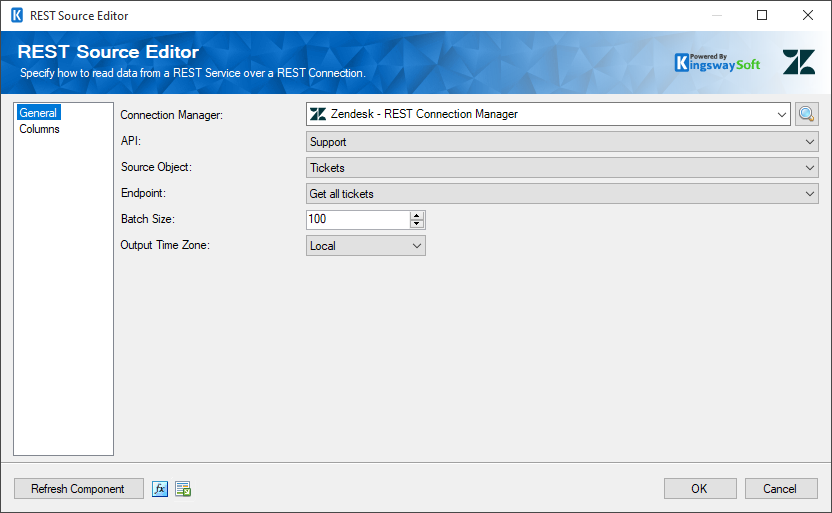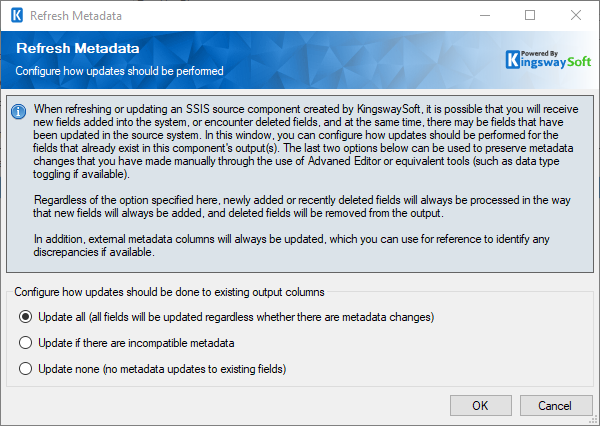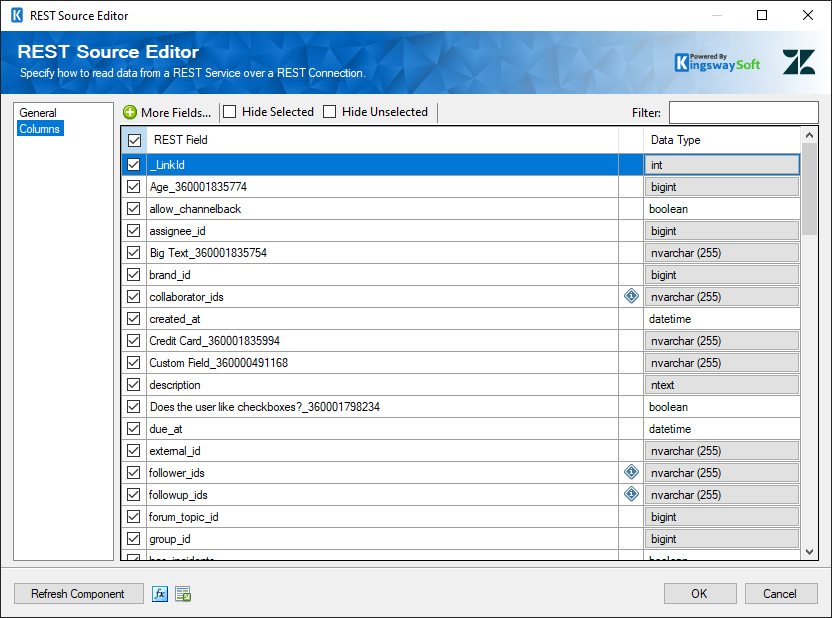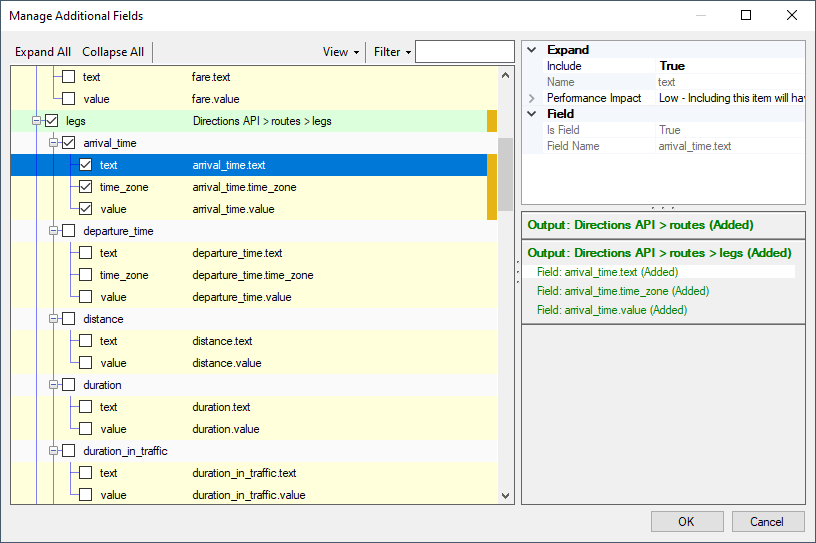Using the Zendesk REST Source Component
The REST Source component is an SSIS source component that can be used to read/retrieve data from Zendesk REST services and produce column data, which then can be consumed by a downstream SSIS pipeline component.
See Zendesk Rest Connection Manager for how to connect to Zendesk and Zendesk REST Destination Component for how to write to Zendesk.
The component includes the following two pages to configure how you want to read data.
- General
- Columns
General Page
The General page of the REST Source Component allows you to specify the general settings of the component.

- Connection Manager
-
The source component requires a REST connection to Zendesk. The Connection Manager drop-down will show a list of all connection managers that are available to your current SSIS package.
- API
-
The API drop-down lists the supported Zendesk API. There are two options:
- Help Center(since v20.1)
- Sunshine(since v21.1)
- Support
- Source Object
-
The Source Object drop-down lists available objects which you can read from.
- Endpoint
-
The Endpoint drop-down lists all available rest endpoints for the selected object.
- Batch Size
-
The Batch Size lets you specify how many records to retrieve per service call to Zendesk.
Note: Some objects do not support batch size, so this option will become disabled.
- Output Time Zone
-
The Output Timezone option lets you specify how all datetime fields should be retrieved. Available options are:
- UTC
- Local
- LinkId Mode
-
The LinkId Mode option allows you to specify how _LinkIId field should be populated. The _LinkId field is a special column that is used to identify records in the parent output. During the runtime, the value of this field will go into the _{parentObjectName}._LinkId field of all this output's children. This is important for linking outputs with each other.
- Implicit (RowIndex): a special field that contains the current count of this output node. This is useful as many times a JSON object will have no key field because relationships are defined hierarchically.
- Explicit (Id): the _LinkId column will be populated with the Id of the parent record.
- Filter Parameters
-
You can specify Filtering Parameters so that the source component only returns those records that satisfy such filtering parameters.
Note: Filter fields may vary from object to object depending on endpoints.
- Refresh Component Button
-
Clicking the Refresh Component button causes the component to retrieve the latest metadata and update each field to its most recent metadata.
(Since v24.1) By clicking on Refresh Component, a new window pops up as shown below, that will have three options to decide how the updates to metadata should be performed.

- Update all: This would update all the fields regardless of whether there are metadata changes.
- Update if there are incompatible metadata: This option would refresh any incompatible metadata to the discovered metadata.
- Update none: No metadata updates would happen to existing fields.
- Expression fx Icon
-
Click the blue fx icon to launch SSIS Expression Editor to enable dynamic updates of the property at run time.
- Generate Documentation Icon
-
Click the Generate Documentation icon to generate a Word document that describes the component's metadata including relevant mapping, and so on.
Columns Page
The Columns page of the REST Source Component shows you all available attributes from the endpoint that you specified on the General page. On this page, you can select the output whose columns you wish to configure in the top left drop-down.

On the top left of the grid, you can see a checkbox, which can be used to toggle the selection of all available fields. This is a productive way to check or uncheck all available fields.
- More Fields…
-
This button will open the Manage Additional Fields editor where you will be able to select additional outputs or fields from the returned object from the server.

-
- Expand All: This button will expand the tree view of all the fields under each object.
- Collapse All: This button will collapse the tree view to only show the sub-objects of the returned JSON document.
- View: This option enables you to view or hide the Details and Summary sections of the Manage Additional Fields editor.
- Filter: This option allows you to only show checked or unchecked items and it can be used to filter the list of fields using a keyword.
- Details section: This section displays the information of the selected field/output including the expected performance impact of the selected item if enabled.
- Summary section: This section displays a summary of what will be added to the component in terms of secondary outputs or fields based on the selected items.
- The Columns Page grid consists of:
-
- REST Field: Column that will be retrieved from the Basecamp REST service.
- Additional Field Details: An information icon will appear here if the column is special. Hover over the icon to see what makes the column special.
- Data Type: The data type of this field.
Note: As a general best practice, you should only select the fields that are needed for the downstream pipeline components.

